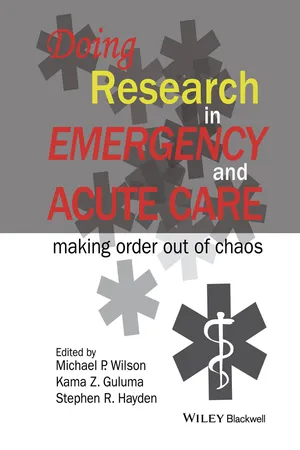
Doing Research in Emergency and Acute Care
Making Order Out of Chaos
- English
- ePUB (mobile friendly)
- Available on iOS & Android
Doing Research in Emergency and Acute Care
Making Order Out of Chaos
About This Book
A practical guide to understanding and navigating the unique challenges faced by physicians and other professionals who wish to undertake research in the ED or other acute care setting.
Focusing on the hyper-acute and acute care environment and fulfilling two closely-related needs:
1) the need for even seasoned researchers to understand the specific logistics and issues of doing research in the ED; and 2) the need to educate clinically active physicians in research methodology.
This new text is not designed to be a complex, encyclopedic resource, but instead a concise, easy-to-read resource designed to convey key "need-to-know" information within a comprehensive framework. Aimed at the busy brain, either as a sit-down read or as a selectively-read reference guide to fill in knowledge gaps, chapters are short, compartmentalized, and are used strategically throughout the text in order to introduce and frame concepts. This format makes it easy - and even entertaining - for the research novice to integrate and absorb completely new (and typically dry) material.
The textbook addresses aspects of feasibility, efficiency, ethics, statistics, safety, logistics, and collaboration in acute research. Overall, it grants access for the seasoned researcher seeking to learn about acute research to empathically integrate learning points into his or her knowledge base.
As the ED is the primary setting for hyper-acute and acute care, and therefore a prime site for related clinical trial recruitment and interventions, the book presents specific logistical research challenges that researchers from any discipline, including physicians, research nurse coordinators, study monitors, or industry partners, need to understand in order to succeed.
Frequently asked questions
Information
PART 1
Getting ready: Preparing for your research study
CHAPTER 1
Aspects of research specific to acute care
Responsibility of the academic physician
Asking the right questions
Challenges with acute care research
- Consent: How are you going to obtain informed consent on the subjects of your study? If you want to carry out a study on resuscitation related measures, how are you expected to truly obtain informed consent when they are in respiratory distress, cardiac arrest, or are altered? Are you going to be there night and day to enroll and obtain consent from these participants?
- Where are you going to do this study? It may seem like an easy question to answer, but let us say you want to carry out a study on prehospital intubations with a new device. Are you going to put the device on every ambulance? If you want to carry out a study in the emergency department regarding a new device for an emergent procedure, where are you going to keep it? Are all the patients requiring that procedure going to go to the same place, or are they going to be spread out all over your 60 bed emergency department?
- Specialists: If you want to carry out a study with a new therapy in acute coronary syndrome, you are going to have to get buy-in from the cardiologists. Our time with these patients in the emergency department is limited, so obtaining agreements to participate from admitting services and specialists is very important and can be incredibly challenging based on your relationships with those services.
- Outcomes: What are the outcomes of your study going to be and how are you going to show that your limited time with this patient population made a difference in those outcomes?
- Blinding: How will you keep the participants and raters in your experiment blinded to their true treatment condition?
- Funding: The answer to many of the questions above is to have resources in place, but resources require funding. How and where will you obtain funding, which is increasingly harder to obtain?
Where do I start?
Table of contents
- Cover
- Title page
- Table of Contents
- List of contributors
- PART 1: Getting ready: Preparing for your research study
- PART 2: Getting it done: Doing your research study
- PART 3: Getting it out there: Analyzing and publishing your study
- Glossary
- Index
- End User License Agreement